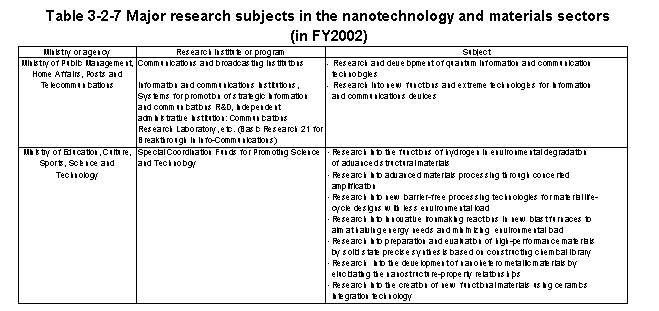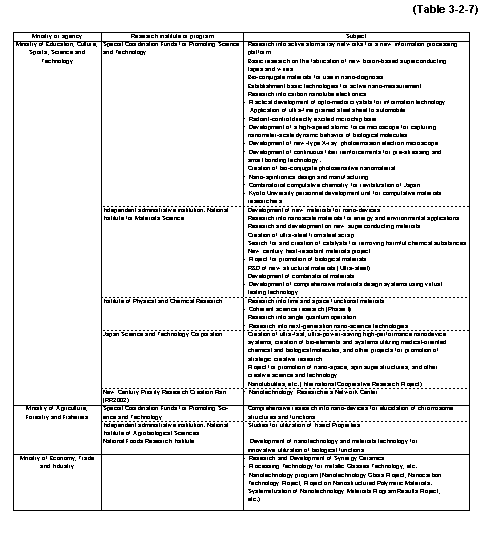| Home > Policy > White Paper, Notice, Announcement > White Paper > WHITE PAPER ON SCIENCE AND TECHNOLOGY2003 > Part3 3.2 3.2.2 3.2.2.4 | ||
The nanotechnology and materials are key technologies for rapid developments over a wide range of scientific and technological areas.Now in the Basic Plan,nanotechnology and materials have located recognition as one of four areas,requiring priority allocation of research and development resources.Nanotechnology is expected to become a major support of all science and technology fields in the21st century,and to lead to a new industrial revolution in the21st century.
The"Promotion Strategies by Sector"drawn up by the Council for Science and Technology Policy in September2001set five areas for priority attention,including"nanodevices and materials for next-generation information and communications systems,""materials for environmental preservation and upgraded use of energy,""nanobiology that utilizes and controls ultra-small systems and materials for medical use and biological mechanisms,""measurement and evaluation,processing,numerical analysis and simulation,and other basic technologies and related sectors,"and"substance and materials technologies that contribute to the realization of revolutionary material properties and functions."It also indicated the need for more active competition and a better environment that encourages competition at R&D sites,promotion of integration between different sectors and between researchers,establishment of system frameworks that facilitate the application of the fruits of re-search in industry,clarification of the responsibilities and roles of industry,academia and government,and further cooperation among these sectors,and the assurance and development of human resources.
| 3.2.2.4.1 Materials Fields |
Japan has to date maintained a high standard of research and development in materials,and will need in the future to take the lead over the rest of the world in technological innovation.In order to promote materials technology,the Second Science and Technology Basic Plan calls for the government to place priority on promotion of R&D in areas where a market mechanism alone cannot lead to strategic and effective results,such as in basic and advanced R&D,and in R&D for basic technologies that lead to industrialization.
For materials R&D,the Plan placed priority on promotion of the following:
In view of the wide-ranging and diverse demands for materials science and technology,relevant ministries and agencies are actively engaged in research and development in many different areas of materials science and technology.
At the Ministry of Education,Culture,Sports,Science,and Technology,the Council for Science and Technology(Subdivision on Research and Development Planning and Evaluation)prepared the"Basic Strategy for Promotion of the Nano-technology and Materials Sectors in the Ministry of Education,Culture,Sports,Science and Technology(interim report)"in June2002.In the field of materials science and technology,the report positioned"materials for environmental protection,""materials for advanced use of energy,""materials for creation of safe space,""basic technologies such as evaluation and processing"and"discovery of materials creating new and advanced functions"as the prioritized areas in meeting the needs of society.
The National Research Institute for Metals and the National Institute for Research in Inorganic Materials were merged in April2001to form an independent administrative institution called the National Institute for Materials Science,which generally and widely promotes basic and fundamental R&D for materials science and technology,including"structural materials for the21st century"and the"superconducting materials."Re-search into materials science and technology is also being promoted through administration of the"Special Coordination Funds for Promoting Science and Technology,"and other similar programs including"Creative Research for Evaluation Science and Technology Program of the Japan Science and Technology Corporation"(JST),and the Frontier Research System,at RIKEN.
The ministry is also encouraging the development of creative and advanced materials research at the Institute for Materials Research and the Institute of Multidisciplinary Research for Advanced Materials at Tohoku University,the Institute for Molecular Science at the Okazaki National Research Institutes,and the Institute for Chemical Research at Kyoto University,as well as using the"Grant-in-Aid for Academic Research Program"for basic research into materials science and technology,in order to promote creative science research at universities and others so that they can serve as sources of free imagination and research inspiration for researchers.
The Ministry of Agriculture,Forestry,and Fisheries,as part of the"Studies for utilization of Insect Properties"by"Encouragement of Centers of Excellence(COE)of the Special Coordination Fund for Promoting Science and Technology",is engaged in research and development for the wider utilization of biomaterials such as fibroin,a silk protein,as a new material having active anti-thrombosis and anti-HIV properties,or the development of materials utilizing the compound capabilities of silk with bone constituents to form artificial bone or artificial ligaments.
The Ministry of Economy,Trade,and Industry is promoting research and development on new materials processing technologies,such as"Frontier Carbon Technology,""Synergy Ceramics,"and"Supermetals."In addition,the ministry promotes cutting-edge,fundamental R&D conducted by international joint research teams funded through the International Joint Research Grant Project(a NEDO grant),to improve the international level of materials science and technology standards.
The Ministry is conducting research and development on fundamental superconductor technologies with the cooperation of industry,academia,and government,primarily led by the New Energy and Industrial Technology Development Organization.
| 3.2.2.4.2 Nanotechnology |
| 3.2.2.4.2.1 Major Policy Proposals for Nanotechnology |
The"Second Science and Technology Basic Plan"notes that,while Japan is either equal to or leading the countries of Europe and the United States in its standards for nanotechnology research and development,the United States and other countries are making very rapid progress in this field.
The Plan also calls for balanced and prioritized promotion of nanotechnology for both basic and advanced R&D and for future industrialization,and notes the importance of building research networks that promote joint efforts and information exchanges between different research areas and researchers,and of developing personnel for new interdisciplinary areas.
The Ministry of Public Management,Home Affairs,Posts and Telecommunications is engaged in research and development of optical functional devices and information memory elements,etc.,as basic research on information communications.
The"Research Committee Regarding Application of Quantum Dynamic Effects to Information and Communications Technology,and Future Prospects(Chairman:University of Tokyo professor Hiroyuki Sakaki)"convened in February2000to study promotion policies for research topics and R&D needed for the creation of innovative quantum information and communications technologies in the21st century.The committee issued a report in June2000.In response,the Ministry of Public Management,Home Affairs,Posts and Telecommunications began in FY2001 promoting"research and development of quantum information and communications technologies,"and is currently implementing research and development at communications and broadcasting institutions for quantum encoding technologies showing promise of practical utilization at relatively early dates.In May2001,the ministry launched the Committee for Promotion of Quantum Information and Communications Research(Chairman:Reona Ezaki,president of Shibaura Institute of Technology),to perform comprehensive investigations of the current state of research and development,and its direction and general strategies,etc.In addition,at the Communications Research Laboratory,the"Information and Communications Breakthrough Basic Research21"program and the"Strategic Information and Communications R&D Promotion Programme"(established in FY2002)are promoting"research into new functions and extreme technologies for information and communications devices,"and are implementing basic research into ultra-compact,ultra-high speed,and ultra-low power consumption information and communications devices,including the development of optical devices for high-speed control and processing of large-capacity signals.
At the Ministry of Education,Culture,Sports,Science and Technology,the"Promotion Policies for R&D in Nanotechnology Materials,"prepared in June2002by the Council for Science and Technology(Subdivision on Research and Development Planning and Evaluation),selected25nanotechnology-related proposals as challenging research that can culminate in practical or industrial application in10or20years,and pointed out the need for the development of a comprehensive support system for nanotechnology.
The Ministry of Education,Culture,Sports,Science and Technology responded to the nanotech report by launching the"Nanotechnology Comprehensive Support Project"within the"New Century Priority Research Creation Plan"(RR2002),which provides broad,integrated support that goes beyond the bounds of existing research institutions and sectors,and offers opportunities for utilization of large and special facilities and equipment to outside researchers,such as ultra high-voltage transmission electron microscopes at project support institutions where selection of users is by public canvassing,and by establishing the Nanotechnology Researchers Network Center,to support the collection and publication of relevant information,and convening of symposiums.In addition,the Japan Science and Technology Corporation utilized the"Project for Promotion of Strategic Creative Research,"launched in FY2002,to implement competitive funding of research and development in"virtual laboratories by nanotechnology field"for10nanotechnology-related research areas expected to reach commercialization in about10years time.
In addition,continuing activities at the National Institute for Materials Science include the development of new materials for nano-devices,research into nano-scale materials for energy and environmental applications,and other nano-materials research,primarily focusing on metallic and inorganic materials.
RIKEN is engaged in basic research,which will form the foundation of nano-science technology for future generations.This includes the measurement and control of nano-level properties and functions,simple quantum manipulation toward the development of new information processing devices,and space-time function materials for manufacturing auto-changing,auto-reacting materials,and materials that can change over time.The Japan Atomic Energy Research Institute(JAERI)is promoting research utilizing ion beams and lasers.Moreover,many universities and colleges are engaged in basic research spanning a wide range of fields.In addition,large synchrotron radiation facilities such as the SPring-8facility contribute to the field as tools for analyses of nano-domains.Meanwhile,a new facility at the National Institute for Materials Science expected to make a large contribution in the future is the920MHz-NMR 37) (Nuclear Magnetic Resonance Facility),the most advanced of its kind in the world.Furthermore,various research funding support programs,including the"Exploratory Research for Advanced Technology Project"operated by the Japan Science and Technology Corporation,and the ministry's Special Coordination Funds for Promoting Science and Technology and the"Grant-in-Aid for Scientific Research Program,"are being used for nano-technology research themes.
The Ministry of Agriculture,Forestry and Fisheries is utilizing information about biological functions obtained at the molecular and cellular level,and cooperation from industry,academia,and government as well as from different technology fields,to promote the development of revolutionary new functional materials and of technologies for the utilization of innovative biological functions through the use of nano-level structural controls,while the ministry's National Foods Research Institute is promoting research into measurements in the nano-domain.
The Ministry of Economy,Trade and Industry promotes the"Nanotechnology Materials Program"for establishing the foundations of nanotechnology,which enables wide-ranging industry sectors to achieve innovative developments,such as improving functionality and characteristics of materials,saving energy and reducing environmental burdens by nano-level control.In FY2002,the ministry proposed"nano-processing and nano-measurement"as a new research and development theme.In addition,the ministry promotes research and development of the"Frontier Carbon Technology"for developing of mass synthesis of carbon nano-tubes.
The major research topics in the nanotechnology and materials science and technology sector con-ducted during FY2001 are shown in Table3-2-7.

Note37)NMR:Nuclear Magnetic Resonance

| Back to Top | MEXT HOME |